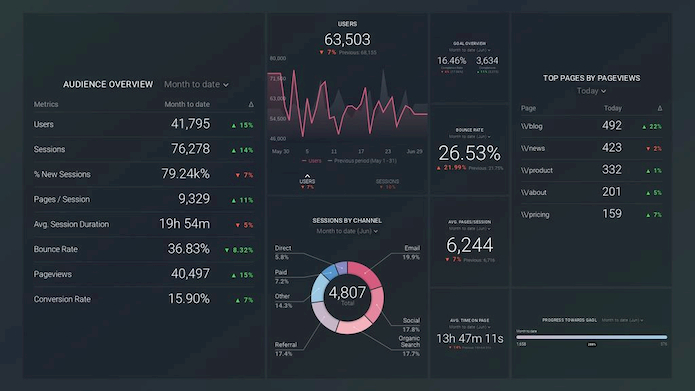Written By:
Kayley Blanchard
The goals that you set for your inbound marketing strategy should be specific, measurable, attainable, relevant, and time-bound. SMART goals help to guide your inbound marketing efforts and allow you to easily measure your progress and determine whether you were successful.
Here, you’ll learn:
-
What an inbound marketing strategy looks like
-
What SMART goals are
-
And why SMART goals are necessary for your inbound marketing strategy
Today’s buyers are more informed than ever before as they have the ability to answer all of their questions with the click of a button. They don’t need you to find them anymore; quite frankly, traditional marketing tactics like cold calling and direct mail can push them away.
Rather, today’s buyers prefer to do their own research; that’s where inbound marketing comes into play. By providing buyers with the valuable information that they need in the form of educational content, you establish trust and credibility and develop a relationship with them. From there, these prospects are likely to move down the funnel, converting to qualified leads and ultimately to paying customers.
Sounds great, right?
Right now, you’re probably wondering how inbound marketing can help your organization to meet its business objectives. Before you can get started on implementing a killer inbound marketing plan, you need to set some solid goals to guide your efforts.
SMART goals are non-negotiable for an effective inbound marketing strategy. Here, we take a deeper look at how SMART goals can strengthen your inbound strategy.
What does an inbound marketing campaign look like?
To understand the importance of goal-setting for inbound marketing, we first need to explore the fundamentals of inbound marketing. What is inbound marketing? How does it work? What does a successful campaign look like? Let’s find out.
The inbound methodology is based on creating meaningful relationships with your audience by providing them with value. Rather than exhausting ineffective and invasive traditional marketing techniques to reach your ideal customer, you’ll reach them by providing them with something of value. Typically, you’ll provide value via helpful content that you’ve optimized to be highly visible in search results and on social media.
The beauty of inbound marketing versus traditional marketing is that you’re genuinely helping your audience, rather than interrupting them.
It’s likely that your ideal customer has a problem that you’re well-equipped to solve. With inbound marketing, you want to effectively guide consumers through the Buyer’s Journey by providing them with the information that they need to solve the problem that they’re having.

Perhaps the consumer doesn’t know what that problem is yet and can’t put a name to it, but they’re trying to figure it out. This consumer would be in the Awareness stage of the Buyer’s Journey. Next, after identifying the problem the consumer wants to solve it; they’re interested in finding all possible solutions. They’ve made their way to the Consideration stage. Lastly, when the consumer has decided on a solution and is weighing their options for possible vendors, they’re in the Decision stage.
An effective inbound marketing campaign takes into account the many questions that consumers may have about a topic as they make their way through the Buyer’s Journey. By answering these questions, you establish your organization as the authority, and build trust with your audience, increasing the likelihood of them becoming paying customers.
To be effective, however, your inbound marketing strategy needs to be well-thought-out and carefully planned. You need to have specific goals set in order for your inbound marketing efforts to be successful; this is where SMART goals come into play.
What are SMART Goals?
SMART Goals are documented goals that are Specific, Measurable, Attainable, Relevant, and Time-bound.
These goals should include specific metrics, or KPIs, that you’re trying to improve, be easy to quantify and measure, be realistic for your organization and relevant to its overall business objectives, and have a designated time-frame during which they should be completed. SMART goals are clear and concise, eliminating the gray area that might otherwise exist.
Download the S.M.A.R.T. Marketing Goals Template
An easy-to-use, free spreadsheet template with step-by-step instructions.

Here’s an example of what a SMART goal might look like for a marketer:
We want to publish 50 high-quality social posts for the quarter so that we can increase social engagements by 15%.
Notice that this goal is specific, measurable, attainable, relevant, and time-bound. Because of this, there’s no room for confusion as to what should be done or by when.
Click here for more examples of SMART marketing goals.
Why Set SMART Goals for your Inbound Marketing Strategy?
You can be an amazing marketer, but without the proper roadmap, you’ll never be able to get where you need to be.
If your goals for your inbound marketing campaign are too broad, it will be impossible to gauge your progress or know when you’ve been successful. In addition, your team might feel confused regarding the tasks at hand.
For example, you might say that one goal of your inbound marketing campaign should be to “Increase our website traffic.” It’s great that you want to increase website traffic for your business, but this goal leaves a lot to the imagination.
Applying the SMART framework, you can turn the aforementioned goal into something like this:
“To boost website traffic by 20% from Q2 to Q3 so that we can generate 100 additional leads for the quarter.”
Knowing that your website traffic goal is an increase of 20 percent, your team can use this benchmark to determine what needs to be done on a daily basis to get there. They can work backward to determine exactly how much content needs to be published within the given timeframe to hit this traffic goal.
Additionally, SMART goals make tracking your progress toward your goals foolproof. By having quantifiable goals set for your chosen metrics, it’s easy to gauge whether or not you’re on the right track.
Let’s say that halfway through your campaign, you see that you’ve only increased your organization’s website traffic by 5 percent. This tells you that your strategy needs to be adjusted if you expect to hit your target by the end of the quarter. Without this goal in place, you would not have otherwise known that your efforts were falling flat.
With SMART goals in place, you can also easily communicate marketing’s contribution to business goals to senior leadership. You’ll be able to quantify the effect of your marketing efforts on overall business objectives and explain how your strategy impacts your organization’s bottom line.
Overall, SMART goals help you to be a more effective marketer and increase your likelihood of success.
Getting Started With SMART Goals
It’s no secret that proper goal-setting is necessary for inbound marketing success. SMART goals keep you on track by guiding your daily efforts, allowing you to track your progress, and making it easy to communicate your success to upper management.
To set SMART goals for your inbound marketing strategy, you’ll want to pick the appropriate metrics that you want to improve, determine your targets, and apply the SMART framework.
Related: How to Set SMART Marketing Goals [Free Template]
After you set your inbound marketing goals, you’ll want to be sure to track your progress and realign your strategy as needed. Tools like Databox allow you to track your SMART goals automatically with a customizable dashboard.

You can share this dashboard with your team on a weekly (or even daily) basis so that everyone is on the same page.
Download our free goal-setting template today to get set your own SMART marketing goals for your inbound campaign.







